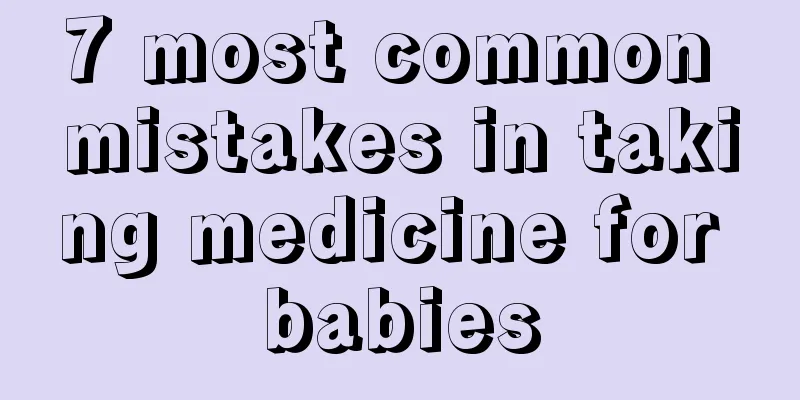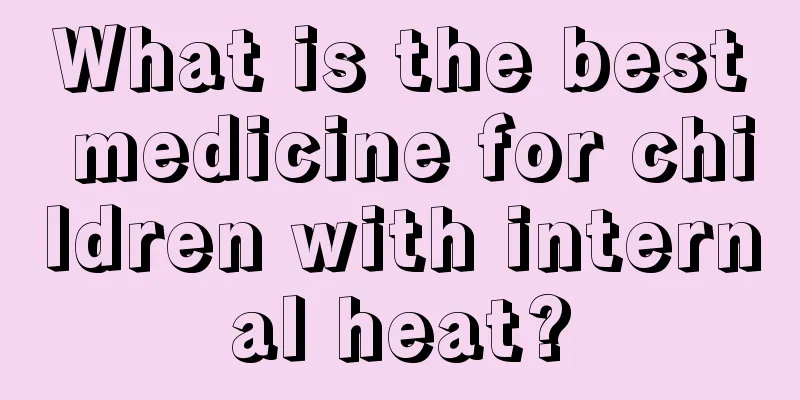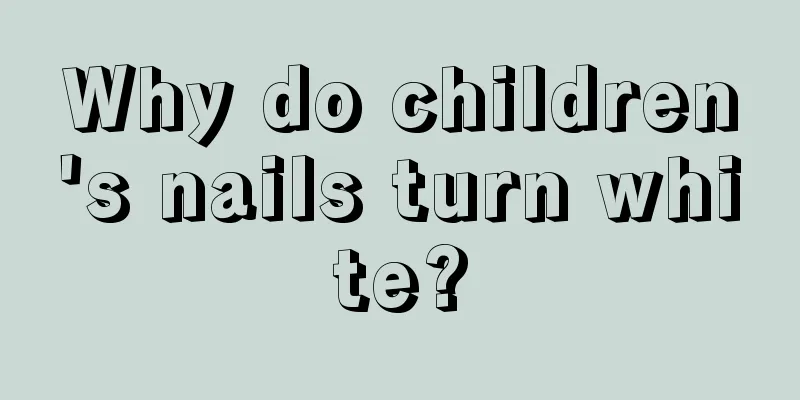7 most common mistakes in taking medicine for babies

|
Every year in my country, approximately 2.5 million people are hospitalized due to medication errors or adverse drug reactions, and as many as 200,000 of them die from improper medication or medication errors. A survey conducted by the Pediatric Pharmacy Group of the Chinese Pharmaceutical Society showed that 70% of children in schools for the deaf and mute in Beijing, Shanghai, Chongqing and other places became deaf and mute due to improper use of medication when they were young. According to a statistic in the 1990s, there are 1.8 million deaf-mute children in my country, 60% of whom, or about 1 million, are deafened due to drugs, and the number is increasing at a rate of 20,000 to 40,000 per year. In fact, most medication problems are not caused by poor quality of the drugs themselves, but by improper selection or use of drugs. Here, I summarize my clinical experience and tell you about the 7 most common mistakes made when taking medicine for babies. Mixing up the drug names and misreading the packaging Statistics from the National Medication Error Reporting Program show that nearly a quarter of medication errors are caused by mixing up drug names. For example, Tylenol for children's fever and Tylenol for children's cold symptoms. Tylenol is a single-ingredient medicine whose active ingredient is acetaminophen. Tylenol (generic name: pheniramine) is a compound drug containing 4 ingredients. In addition to acetaminophen, it also contains pseudoephedrine hydrochloride, dextromethorphan hydrobromide and chlorpheniramine maleate. It is not recommended to use compound cold medicines for children now, because children's colds are mostly caused by viruses. It is only necessary to use antipyretics to control the body temperature below 38.5℃, and they can usually heal themselves within 5 to 7 days. For children with persistent high fever, we generally recommend using Tylenol. If one confuses the drug names and chooses Tylenol, the fever may not go away. Instead, the child may suffer from side effects such as drowsiness, fatigue, and loss of appetite, which is not conducive to recovering physical strength and may prolong the course of the disease. The similarity of drug packaging is also an issue that cannot be ignored, especially for different drugs produced by the same pharmaceutical company. For example, the commonly used children's medicines Tylenol Drops, Motrin Drops and Essex Drops are three different medicines produced by the same pharmaceutical factory. However, recently their packaging has become more and more similar, not only in size but also in color. Therefore, parents who have different medicines from the same pharmaceutical company at home also need to be extra careful. Remember to check carefully before giving the medicine to their baby, and ask someone to check if necessary, to avoid taking or using the wrong medicine.
Many parents have an illusion that the more medicine a child takes, the faster the disease will heal, so they combine Chinese and Western medicines and take multiple medicines together. In fact, whether it is Chinese medicine or Western medicine, most drugs entering the body must be metabolized and inactivated by the liver and excreted and eliminated by the kidneys. Since children's liver and kidney functions are not yet fully developed, they should try to avoid taking multiple medications at the same time to prevent liver and kidney damage. If your condition requires taking multiple medicines at the same time, you should also know how to take them correctly. For example, when Chinese and Western medicines need to be taken together, we generally recommend that the two medicines be taken at least 1 hour apart. When taking multiple drugs at the same time, you also need to pay attention to the active ingredients of each drug to avoid duplication of drugs and aggravate adverse reactions. Once again, it is emphasized that the ingredient acetaminophen used to reduce fever is also present in many compound cold medicines (see Appendix 2, "Analysis of Active Ingredients in Common Cold Medicines," page 243). If you take compound cold medicines while reducing fever, you may overdose on acetaminophen and cause liver damage. For example, the anti-allergic ingredient chlorpheniramine maleate is also found in many compound cold medicines. Chlorpheniramine may be written in the ingredient list. If parents do not know that the commonly known chlorpheniramine is chlorpheniramine, and they give their baby chlorpheniramine and cold medicine containing chlorpheniramine at the same time, it can easily cause an overdose of chlorpheniramine, causing the baby to fall into drowsiness, and in severe cases, loss of consciousness.
Medicines have different dosage units, such as milliliter (mL), milligram (mg), etc. Sometimes, some doctors like to use abbreviations, which poses a great safety hazard. Parents are reminded to carefully identify them. For example, the dose of anti-allergic cetirizine drops for children under two years old is 0.25 ml (equivalent to 2.5 mg) each time. Some doctors like to write 2.5 mg. If the 2.5 mg here is mistakenly read as 2.5 ml, the amount given to the child will reach a toxic dose, and in severe cases it will lead to the death of the child. Such examples have been reported in the United States. Tylenol has two concentrations of products on the Chinese market. The drug concentration of the suspension is 160 mg/5 ml, while the concentration of the drops is 500 mg/5 ml. If parents do not check the concentration carefully, it is easy to give the wrong dose.
The health care product market has always been booming. Many parents are afraid that their babies may lack vitamins or trace elements, so they choose to give their children health care products. In order to attract babies with good taste, manufacturers of health care products have made their products taste so good that many babies eat them as candy. For example, many mothers buy "Gummy Bears" from overseas for their babies. This is a children's multivitamin that tastes good and looks cute, and children love it. There have been many reports of overdosage of gummy bears abroad, all of which were caused by children accidentally taking them when their parents were not paying attention. Eating too much health supplements can also cause poisoning. Parents are reminded to tell their babies that these are not sugars and to keep health supplements out of their reach or lock them in a cabinet. Misuse of antibiotics When babies catch a cold and have a fever, parents are first concerned that the baby may develop pneumonia, so they give them antibiotics at will to prevent it. In fact, it is not so easy for a cold and fever to develop into pneumonia. Antibiotics can be used to treat bacterial pneumonia, but they cannot prevent pneumonia. To prevent pneumonia, you can consider getting a pneumonia vaccine. The misuse of antibiotics will increase the probability of antibiotic resistance, resulting in antibiotics no longer being effective when the baby really needs them. There are still some misunderstandings about the use of antibiotics: First, stop taking antibiotics immediately after the illness is cured; not using them for a full course of treatment can easily lead to bacterial resistance. Second, arbitrarily discontinuing or frequently changing antibiotics. The use of antibiotics to treat bacterial infections is a gradual process that takes 2 to 3 days to see results. It is not an immediate effect after taking a single dose, so do not stop using the antibiotics at will or change them frequently. Third, the newer the antibiotic, the better. As soon as you enter the hospital, ask the doctor to prescribe a third-generation cephalosporin. In fact, there is no saying that one antibiotic is more powerful than another. The pathogens of different infection sites are different, so different antibiotics target different pathogens. For example, for skin and soft tissue infections, first-generation cephalosporins are very effective.
Since Western medicines are approved for marketing only after clinical trials, any adverse reactions that occur during the trial will be noted in the drug instructions. Since traditional Chinese medicine is the inheritance of the motherland's medical culture, there are no particularly strict clinical trials, so the adverse reactions in the drug instructions are usually marked as "not yet clear." “Not yet clear” only means that there is no clinical data to refer to, and does not mean it is safe. Medicines that are 100% plant-based do not mean they are 100% safe. You should know that many Western medicines also originally come from plants, such as aspirin. Parents are reminded not to give their babies so-called "small Chinese medicine" to strengthen their bodies at will, and to remember that "all medicines are poisonous to some extent."
Due to the frequent safety issues of Chinese medicines, parents choose to buy medicines overseas, which actually involves great risks. First, due to language barriers, many parents are unable to understand the true purpose, usage and dosage of overseas purchased medicines. For example, when you buy "Little Bee" comfrey ointment, merchants may exaggerate its efficacy and say it is an edible universal ointment. But in fact, it is only used to refresh the mind and relieve fatigue in the United States. It is only for people over two years old and can be used no more than 3 to 4 times a day. Children under two years old should consult a doctor before using it. Its main ingredient is extracted from the comfrey plant. The U.S. Food and Drug Administration has issued a liver toxicity warning for its oral supplements, so when applying it externally, avoid broken skin to avoid liver toxicity. Second, due to the lack of supervision of online merchants, it is difficult to ensure the quality of medicines purchased overseas, and it is also difficult to obtain timely information on adverse reactions of medicines. For example, someone bought an ointment online to relieve teething discomfort, and the ingredient list indicated that it contained benzocaine. In fact, because this ingredient may cause severe methemoglobinemia, both the U.S. Food and Drug Administration and the China Food and Drug Administration have issued warnings: Do not use ointments containing benzocaine on children under two years old. Choose teething gels or use your fingers to massage the gums to relieve the discomfort of teething. |
<<: Nine daily necessities that are harmful to babies!
>>: The 7 types of dads most likely to ruin their children, are you one of them?
Recommend
Why do children vomit after drinking water?
In summer, due to diet, many people's stomach...
How many months is it best to wean your baby off breast milk?
What I want to talk to you about today is the bes...
How to treat children's astigmatism and amblyopia_How to treat children's amblyopia and astigmatism
Nowadays, many parents always feel that their chi...
How to make the baby reach normal height
There are only a few periods in a person's li...
What are the early symptoms of asthma in children?
Children with asthma are prone to attacks if pare...
Treatment of congenital heart disease in children
I don't know if you have heard of congenital ...
What are the symptoms of acute pharyngitis in babies?
Acute pharyngitis is a relatively common disease....
What should I do if my newborn baby is breathing rapidly while feeding?
The dietary health of newborns is a matter that p...
Is it OK for children to use air conditioning?
In summer, it is June and July, which are the hot...
Is hematuria in children life-threatening?
Both men and women can have hematuria, and it can...
Reasons why two-month-old babies don't sleep
Nowadays, parents pay little attention to their c...
What should children pay attention to during their tooth replacement period?
Tooth replacement is something that everyone will...
Nine month old baby has red spots on his body
The most common causes of red spots on a nine-mon...
What to do if your child sweats a lot
The baby is the treasure of the family. Parents w...
Acne on the face of a child
Acne is a skin disease that often occurs on the f...









